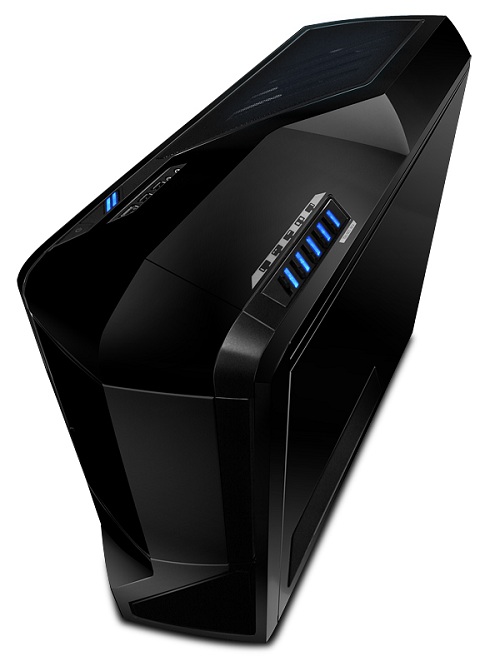
This post is syndicated with permission from GamerFront.net
When it comes to your PC, looks aren’t everything. I believe the old phrase is “don’t judge a book by its cover.” Despite this, most gamers like to have a case that can turn heads, or at least cock a few eyebrows. Well that was exactly what case maker NZXT was going for when designing their latest chassis, dubbed the Phantom.
It’s easy to look at pictures of a new case and tell that it’s going to look pretty good. But honestly you just never know if it’s going to stack up when the box shows up at your door. Or maybe it looks good, but the materials used are flimsy and the inside is poorly designed. Well you needn’t worry here, as we were fortunate enough to have one of these land on our doorstep not too long ago, and we’ve had a chance to look it over, install components and use it as a primary case for a bit. So does it stack up? Keep reading for our verdict.
First Glance
When your friends walk into the room that houses your computer for the first time, chances are it’s the first thing the look at. Usually the case speaks volumes about the person’s computing habits, and of what lies within. The Phantom is not a flashy case by any means. You won’t find a lot of unnecessary lights, windows or trim here. Rather, it has a sleek shine and interesting angles. You will see one soft blue light coming from the top, but it isn’t overbearing. It can even be turned off by pressing an easily-accessible button located on the rear of the case. Single blue LEDs are also seen for the power, hard drive status and fan control.
The case is also massive. It stands at roughly 24.5in x 8.7in x 21.2in. (LxWxH). So you know just from looking at it that there is room for pretty much anything you’d want to pack in there. Overall, I’d say that the case doesn’t cry out “look at me, look at me!” Instead, it draws you in with its sleek design and begs you to look under the hood.
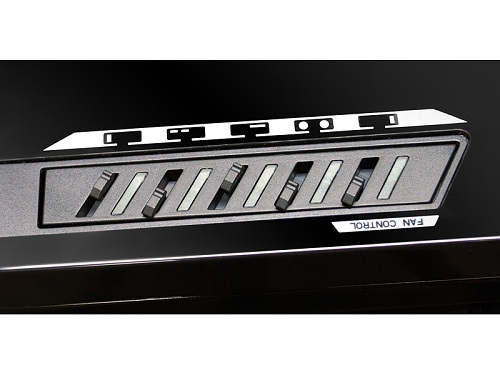
Closer Look
On the top of the case you will find your usual power and reset buttons mounted flush. Behind them are a series of connectors, including two USB ports, an eSATA port and two audio jacks. You’ll also find five slider switches, each marked by a symbol and a blue LED. The sliders allow you to adjust the speed of the 5 included fans. The symbols of course tell you which slider goes to the right fan.
There’s not a lot to see on the bottom, except for a set of long, rubber-coated feet to keep the machine stable, and a vent for your power supply. The front has a door that opens to reveal five external drive bays. You can see that the mesh plates covering each of these can be easily removed, as they are held in place with a slider-latch. One finger is all it takes to remove them.
Inside you will see the fans mentioned above. On top is a large 200mm, which features a set of four soft blue LEDs. The front of the case houses a 140mm, while the rear is a 120mm. Two more 120mm fans are located on the side panel, which are situated directly over the drive bays. Speaking of drive bays, you will see the 5 external 5.25” bays and 7 internal 3.5” ones, which can be made to accommodate 2.5” SSDs.
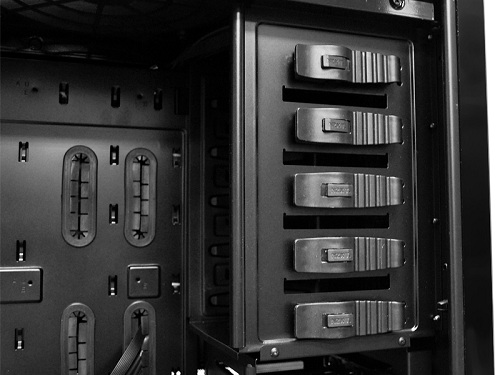
Also seen on the inside are several holes used for cable management. These are covered with rubber flaps that will hold your cables in place without simply looking like large gaping holes in the case. There is, however, a large open rectangle where the CPU portion of the motherboard will sit. This is to make changing out CPU brackets a breeze, as you will not be required to remove the entire motherboard to do so.
Installation
If you purchase a good case, it should be able to outlast the hardware that goes in it. This means that you’ll want the installation and removal of parts to go as smoothly as possible. The case is mostly a screwless design, it should be a snap to swap out components.
Surprisingly, this case is probably the easiest I’ve ever worked with when it comes to installation. Part of this is due to the sheer size of the case. You have about 14” x 16” x 8” (LxHxD) of open space to work with. There is plenty of room for your hands to fit in there while trying to run cables and position hardware. Even with an extra-long graphics card there was still space to spare.
The screwless design of the optical bays is the best I’ve ever used. The entire process of removing the front plate, inserting the drive and securing it takes about 5 seconds. The front plate is held in place by a slider latch, which is removed without the need to take off the entire front of the case. Inside there is a clip which you pull back while inserting the drive, and push back into place to secure the drive. That part is a little hard to describe, so I’ve included the promotional video from NZXT below. It will give you a better idea of how easy the installation is. (Optical drive installation is at around the 56 second mark.)
The hard drives are almost as easy to install. Each sits on a bracket plate, which snaps to the drive without the need for any screws at all. Slide the drive into the desired location and you’re finished. You’ll still need screws for the motherboard, power supply and graphics card, though the last two use thumbscrews, so you’ll still not have to mess with any tools for them.
I’m a stickler for cable management, and once again this case didn’t disappoint. The open space and included cable management holes made things a breeze. One surprise I hadn’t anticipated was actually behind the other side panel. They actually gave you extra space back there to accommodate any cables you might be running. Usually it’s a strain to get the main 24-pin motherboard connecter to run through cable management holes on other cases. (Yes, I’m that anal about running cables inside of a case.) However there was no trouble whatsoever with the Phantom. There’s an inch of extra space, so there was no difficulty when trying to put the side panel back on.
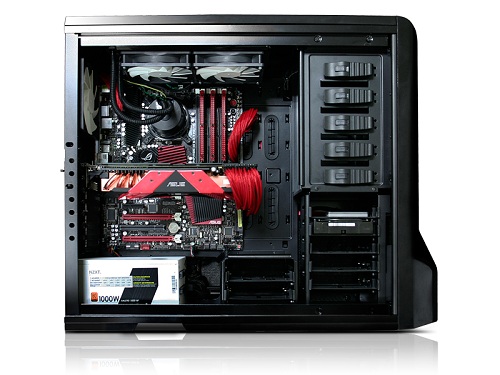
Final Thoughts
The Phantom has it everywhere that counts. It’s sleek design is attractive without being overbearing. Installing components is a quick and painless task, and the solid steel construction ensures that this case is going to last much longer than the parts you put in it. Unless you have a limited amount of space to put your computer, this case is not going to disappoint.
You can pick from three different color schemes, which are black, red and white. The mesh grills located on the top and sides are all going to be black, regardless of what color you pick for the rest of the case. Ours was solid black, which is usually what I prefer in a case. It does look great, but I think the contrast of red/black and white/black will really make it stand out (in a very good way).
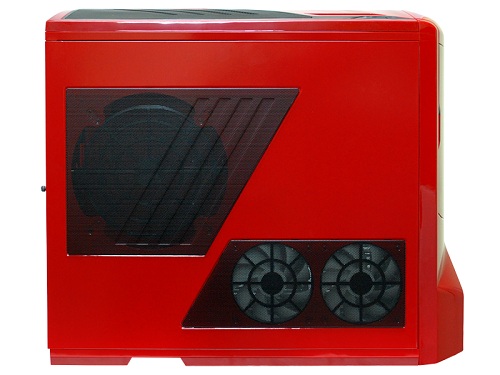
The last thing I’ll touch on is the price. The Phantom will set you back $140 when it launches in September. You’ll be hard-pressed to find a full-tower case of this quality for a price like that. Whether you have a lot of hardware to install, or just like having that extra room inside, this is going to be the perfect case for you.
[ NZXT ] VIA [ GamerFront ]





I honestly think I have found my new case! I have honestly been looking for one that has everything I need and room for more just in case I get to that point. This by far the best case for the price I have seen. It doesn't have all that flashy stuff either which does look nice if your show boating your tower. Since though I'm most liking going to be the only one that sees my Tower I feel like this one appeals to me. I can't wait for the release!
My god that is the sexiest thing since sex. That is an unbelievlbly sleek case. Its got all the features you would expect from a high end case, nothing special there, but thats not a bad thing. I know i would sleep better at night seeing that on my desk before i close my eyes.
Can somebody please tell me what that thing over the CPU is in the second to last picture?